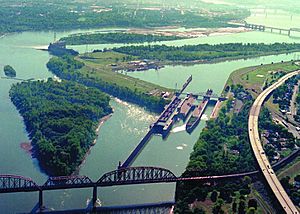McAlpine Locks and Dam facts for kids
Quick facts for kids McAlpine Locks and Dam |
|
|---|---|

McAlpine Locks and Dam, Louisville, Kentucky
|
|
| Official name | McAlpine Locks and Dam |
| Location | Louisville, Kentucky |
| Coordinates | 38°16′41″N 85°47′32″W / 38.2781°N 85.7922°W |
| Opening date | 1830 |
| Operator(s) | United States Army Corps of Engineers Louisville District |
| Dam and spillways | |
| Impounds | Ohio River |
| Power station | |
| Operator(s) | Louisville Gas & Electric |
| Installed capacity | 80 MW |
The McAlpine Locks and Dam are a big structure on the Ohio River in Louisville, Kentucky. It includes special water elevators called locks and a hydroelectric dam. This dam helps make electricity from the river's water.
This important place is found at the Falls of the Ohio. It helps control a long stretch of the river, about 72.9 miles (117.3 kilometers) long. The locks and a canal here were the first big engineering project on the Ohio River. They were finished in 1830.
This project was called the Louisville and Portland Canal. Its main job was to help boats and ships get past the rocky parts of the Falls of the Ohio. Before this, it was very hard for boats to travel through this area.
How the McAlpine Dam Was Built
From 1925 to 1927, more parts were added to the dam. A special plant was built to make hydroelectric power. This means using the force of moving water to create electricity.
The locks were also made bigger during this time. A private company started the work, and then the U.S. Army Corps of Engineers finished it. The hydroelectric plant here was once the seventh largest in the whole United States!
In 1960, the system was given a new name: the McAlpine Locks and Dam. This was to honor William McAlpine. He was the only regular person, not a military officer, to ever lead the Corps of Engineers district in Louisville.
Today, the water level above the dam is about 420 feet (128 meters) above sea level. A huge area of 91,170 square miles (236,000 square kilometers) drains into the river above the dam. On average, 118,000 cubic feet (3,340 cubic meters) of water flow past McAlpine every second.
The lock chambers are on the Kentucky side of the Ohio River. They can lift or lower boats by about 37 feet (11 meters). This helps boats move between the higher water level of the McAlpine pool and the lower water level of the Cannelton pool downstream.
The hydroelectric plant has eight big machines called turbines. These turbines can make 80,000 kilowatts of electricity. That's enough power for many homes!
In October 2003, the McAlpine Locks and Dam were recognized as a Historic Civil Engineering Landmark. This is a special award from the American Society of Civil Engineers. It means the dam is an important example of great engineering.
The McAlpine locks had a big improvement project that cost $278 million. It took 10 years and was finished in early 2009. This made the locks even better for river traffic.
Who Manages the Dam?
The hydroelectric plant, which makes electricity, is owned and run by Louisville Gas & Electric. This company is part of a bigger company called PPL Corporation.
The locks themselves, which help boats move up and down the river, are managed by the Army Corps of Engineers. They make sure the locks work smoothly for all the boats that use the Ohio River.
| Locks and dams of the Ohio River | ||
|---|---|---|
|
||
| Upstream: Markland Locks and Dam |
Downstream: Cannelton Locks and Dam |
|
Images for kids
















